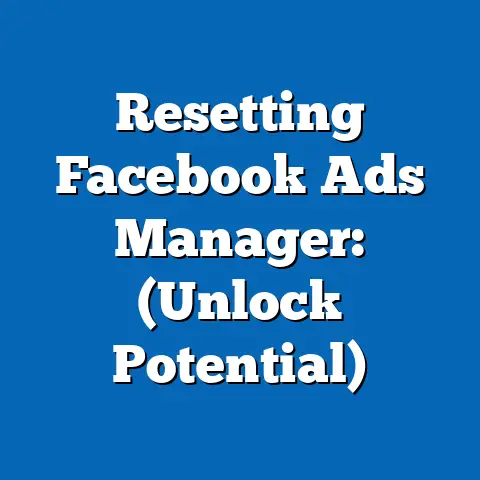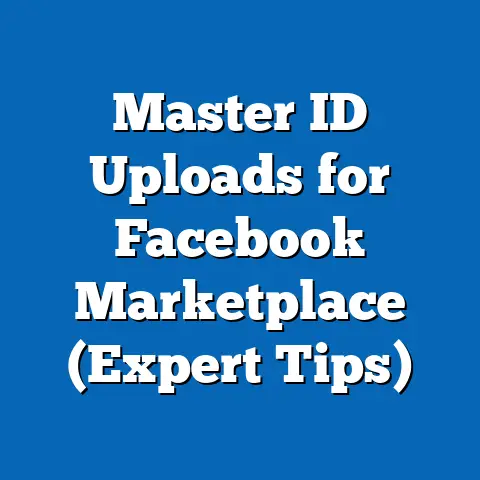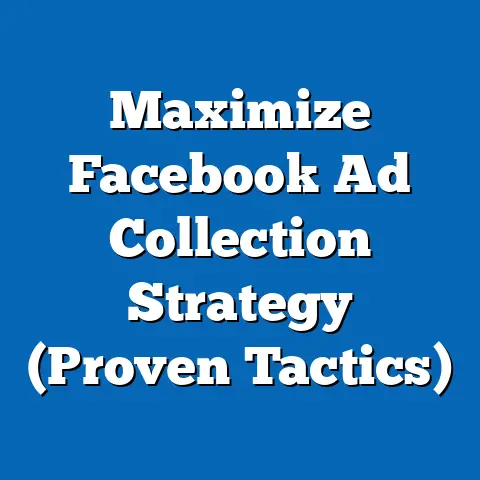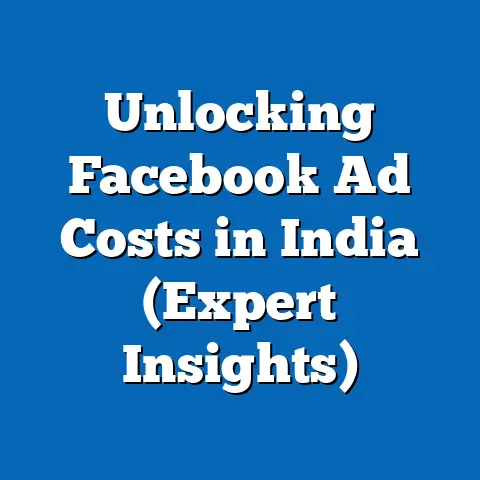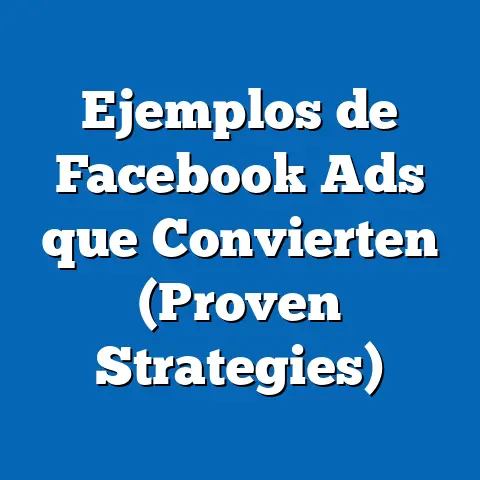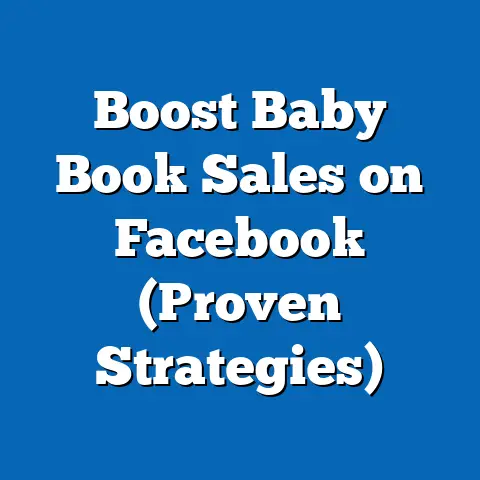Master Facebook Link Ads Specs (Insider Strategies Unveiled)
Let’s face it, the digital world is loud. It’s a constant barrage of information, vying for our attention. Think of your own Facebook feed – a never-ending scroll of updates, memes, and, yes, ads. Cutting through that noise and making your message heard is the ultimate challenge for any advertiser. This is where mastering Facebook Link Ads comes into play.
What do I mean by “noise?” In the context of Facebook ads, noise is anything that distracts from your core message. It could be irrelevant targeting, a poorly designed creative, or even just a vague call to action. The more noise you have, the less effective your ad will be. Think of it like trying to have a conversation at a rock concert – you have to shout to be heard!
Why is reducing noise so vital? Because attention is a scarce resource. Users are bombarded with thousands of messages every single day. If your ad doesn’t immediately grab their attention and offer something valuable, it’ll be lost in the shuffle. This isn’t just about being seen; it’s about making an impact.
I’ve personally experienced the frustration of seeing a campaign underperform due to avoidable noise. I once worked with a client whose ads were beautifully designed but had incredibly generic copy. The result? High impressions but abysmal click-through rates. We revamped the copy to be more specific and compelling, and boom – engagement skyrocketed!
Section 1: Understanding Facebook Link Ads
So, what exactly are Facebook Link Ads? Simply put, they are advertisements designed to drive traffic from Facebook to an external website, landing page, or other online destination. They’re a cornerstone of many Facebook advertising strategies, acting as a bridge between the social platform and your online presence.
Link Ads are incredibly versatile and can be used for a wide range of objectives, including:
- Driving website traffic: This is the most common use case. Use Link Ads to send potential customers to your website to browse products, read blog posts, or learn more about your business.
- Generating leads: Direct users to a landing page where they can sign up for a newsletter, request a demo, or download a free resource.
- Promoting content: Share your latest blog posts, videos, or articles to increase brand awareness and establish yourself as an authority in your industry.
- Driving app downloads: Send users directly to the app store to download your mobile application.
- Increasing sales: Direct users to product pages on your website to encourage immediate purchases.
Now, let’s talk about how Link Ads differ from other ad formats on Facebook. While Facebook offers a variety of ad types, including image ads, video ads, carousel ads, and collection ads, Link Ads stand out because of their primary focus on driving external traffic.
Here’s a quick comparison:
- Image Ads: Great for visual appeal and brand awareness but might not always drive direct clicks.
- Video Ads: Excellent for storytelling and engagement but can be more expensive to produce.
- Carousel Ads: Allow you to showcase multiple products or features in a single ad unit.
- Collection Ads: Designed for e-commerce, allowing users to browse and purchase products directly within the Facebook app.
- **Link Ads: Simple, direct, and highly effective for driving traffic to your desired destination.
Link Ads are often the most cost-effective option for businesses that prioritize website traffic and lead generation. They offer a clear and concise way to guide users from Facebook to your online properties.
I’ve seen countless businesses successfully use Link Ads to grow their online presence and drive sales. For example, a local bakery used Link Ads to promote their new seasonal menu, directing users to their website to place orders. The result? A significant increase in online sales and a boost in brand awareness.
The role of Link Ads in the customer journey is crucial. They act as a vital touchpoint, guiding potential customers from the awareness stage to the consideration and conversion stages. By carefully crafting your Link Ads and targeting the right audience, you can effectively move users through the sales funnel and achieve your business goals.
Key Takeaway: Facebook Link Ads are a fundamental tool for driving traffic and achieving various business objectives. Understanding their purpose and how they differ from other ad formats is essential for crafting effective campaigns.
Section 2: Specifications of Facebook Link Ads
Okay, let’s get down to the nitty-gritty – the technical specifications that govern Facebook Link Ads. Ignoring these specs is like trying to fit a square peg into a round hole – it simply won’t work! Adhering to these guidelines ensures your ads look their best, perform optimally, and avoid being rejected by Facebook.
Here’s a breakdown of the key specifications:
-
Image Size and Aspect Ratio:
- Recommended Image Size: 1200 x 628 pixels
- Aspect Ratio: 1.91:1
- Minimum Image Size: 600 x 315 pixels
- Why it matters: Using the correct image size and aspect ratio ensures your image displays correctly across all devices and placements. Avoid blurry or distorted images, which can negatively impact user perception.
-
Text Character Limits:
- Headline: Up to 25 characters
- Description: Up to 30 characters
- Primary Text: Up to 125 characters (though longer text is possible, shorter is generally better)
- Why it matters: These limits are in place to maintain a clean and uncluttered ad experience. Keep your copy concise, compelling, and focused on your key message.
-
Call-to-Action (CTA) Button:
- Options: Shop Now, Learn More, Sign Up, Download, Watch More, Book Now, Contact Us, Apply Now, See Menu, Get Offer, Donate Now, Get Quote, Listen Now, Subscribe and more.
- Best Practices: Choose a CTA that aligns with your ad objective and the action you want users to take. For example, use “Shop Now” for e-commerce ads and “Learn More” for informational content.
- Why it matters: A clear and relevant CTA encourages users to click and take the desired action.
-
Link Preview:
- How it works: Facebook automatically generates a link preview based on the metadata from your website.
- Ensuring correct display: Use the Facebook Sharing Debugger (https://developers.facebook.com/tools/debug/) to preview how your link will appear and troubleshoot any issues.
- Why it matters: A properly displayed link preview enhances credibility and encourages clicks. Make sure your website’s metadata is accurate and up-to-date.
Image Size and Aspect Ratio:
- Recommended Image Size: 1200 x 628 pixels
- Aspect Ratio: 1.91:1
- Minimum Image Size: 600 x 315 pixels
- Why it matters: Using the correct image size and aspect ratio ensures your image displays correctly across all devices and placements. Avoid blurry or distorted images, which can negatively impact user perception.
Text Character Limits:
- Headline: Up to 25 characters
- Description: Up to 30 characters
- Primary Text: Up to 125 characters (though longer text is possible, shorter is generally better)
- Why it matters: These limits are in place to maintain a clean and uncluttered ad experience. Keep your copy concise, compelling, and focused on your key message.
Call-to-Action (CTA) Button:
- Options: Shop Now, Learn More, Sign Up, Download, Watch More, Book Now, Contact Us, Apply Now, See Menu, Get Offer, Donate Now, Get Quote, Listen Now, Subscribe and more.
- Best Practices: Choose a CTA that aligns with your ad objective and the action you want users to take. For example, use “Shop Now” for e-commerce ads and “Learn More” for informational content.
- Why it matters: A clear and relevant CTA encourages users to click and take the desired action.
Link Preview:
- How it works: Facebook automatically generates a link preview based on the metadata from your website.
- Ensuring correct display: Use the Facebook Sharing Debugger (https://developers.facebook.com/tools/debug/) to preview how your link will appear and troubleshoot any issues.
- Why it matters: A properly displayed link preview enhances credibility and encourages clicks. Make sure your website’s metadata is accurate and up-to-date.
Why is adhering to these specifications so important? Several reasons:
- Improved User Experience: Properly sized images, concise text, and clear CTAs create a more pleasant and engaging ad experience for users.
- Increased Click-Through Rates (CTR): Ads that look professional and relevant are more likely to attract clicks.
- Higher Quality Score: Facebook rewards ads that provide a good user experience with a higher quality score, which can lead to lower advertising costs.
- Reduced Risk of Ad Rejection: Failing to meet the specifications can result in your ads being rejected by Facebook, delaying your campaigns.
I remember a time when I was rushing to launch a campaign and completely overlooked the image size requirements. The ads were approved, but they looked terrible on mobile devices – stretched and distorted. The result? A significant drop in CTR and wasted ad spend. Lesson learned: always double-check your specs!
Key Takeaway: Mastering the technical specifications of Facebook Link Ads is crucial for optimizing ad performance and avoiding common pitfalls. Pay close attention to image sizes, text character limits, CTA options, and link previews to ensure your ads look their best and achieve their objectives.
Section 3: Crafting Compelling Link Ads
Now that we’ve covered the technical aspects, let’s dive into the art of crafting compelling Link Ads. This is where creativity and strategy come together to create ads that truly resonate with your target audience.
The first key element is compelling visuals. Your image is the first thing users will see, so it needs to grab their attention and communicate your message effectively.
Here are some tips for choosing images that resonate:
- Relevance: Choose images that are directly relevant to your product, service, or offer.
- High Quality: Use high-resolution images that are clear, crisp, and visually appealing.
- Emotion: Select images that evoke emotion and connect with your target audience on a personal level.
- Authenticity: Avoid stock photos that look generic and staged. Opt for authentic images that showcase your brand’s personality and values.
- Testing: Don’t be afraid to test different images to see what resonates best with your audience.
Next up is persuasive ad copy. Your ad copy is your opportunity to tell a story, highlight the benefits of your offer, and convince users to click.
Here are some strategies for writing persuasive ad copy:
- Know your audience: Understand their needs, interests, and pain points. Tailor your copy to address their specific concerns.
- Highlight benefits, not just features: Focus on how your product or service will improve their lives or solve their problems.
- Use strong verbs and action words: Encourage users to take action by using verbs like “Shop Now,” “Learn More,” or “Sign Up.”
- Create a sense of urgency: Use language that creates a sense of urgency, such as “Limited Time Offer” or “While Supplies Last.”
- Keep it concise and easy to read: Use short sentences, clear language, and bullet points to make your copy easy to scan.
The headline and description play a crucial role in attracting clicks. Your headline is the first thing users will read, so it needs to be attention-grabbing and informative. Your description provides additional context and encourages users to learn more.
Here are some tips for crafting effective headlines and descriptions:
- Headline:
- Keep it short and sweet (under 25 characters).
- Highlight the main benefit of your offer.
- Use strong keywords that will attract your target audience.
- Description:
- Provide additional context and details about your offer.
- Address potential questions or concerns.
- Include a clear call to action.
- Keep it short and sweet (under 25 characters).
- Highlight the main benefit of your offer.
- Use strong keywords that will attract your target audience.
- Provide additional context and details about your offer.
- Address potential questions or concerns.
- Include a clear call to action.
I once worked with a client who was struggling to generate leads through their Facebook ads. Their ads had beautiful images, but the copy was bland and uninspiring. We rewrote the copy to be more benefit-driven and added a clear call to action. The result? A significant increase in lead generation and a much higher ROI.
Key Takeaway: Crafting compelling Link Ads requires a combination of visually appealing images and persuasive ad copy. Understand your audience, highlight benefits, and use strong calls to action to drive clicks and achieve your advertising goals.
This is where you go beyond the basics and leverage advanced techniques to maximize your ROI.A/B Testing: This is arguably the most powerful tool in your arsenal. A/B testing involves creating multiple versions of your ad and testing them against each other to see which performs best.
Here are some elements you can A/B test:
- Images: Test different images to see which resonates best with your audience.
- Headlines: Test different headlines to see which attracts the most clicks.
- Descriptions: Test different descriptions to see which provides the most compelling information.
- CTAs: Test different CTAs to see which drives the most conversions.
- Targeting: Test different audiences to see which is most receptive to your message.
Facebook makes A/B testing incredibly easy with its built-in “Split Testing” feature. This allows you to create multiple ad sets with different variations and automatically track their performance.
Leveraging Facebook’s Audience Insights: Understanding your audience is crucial for creating effective ads. Facebook’s Audience Insights tool provides valuable data about your target audience, including their demographics, interests, behaviors, and more.
Use this data to:
- Refine your targeting: Target your ads to the most relevant audience segments.
- Tailor your ad copy: Craft ad copy that speaks directly to your audience’s needs and interests.
- Choose the right images: Select images that will resonate with your target audience.
Retargeting: This is a powerful strategy for engaging users who have previously interacted with your brand. Retargeting allows you to show ads to users who have visited your website, watched your videos, or engaged with your Facebook page.
Here are some retargeting strategies you can use:
- Website Visitors: Show ads to users who have visited specific pages on your website.
- Facebook Page Engagers: Show ads to users who have liked, commented, or shared your Facebook posts.
- Video Viewers: Show ads to users who have watched a certain percentage of your videos.
- Lead Form Submitters: Show ads to users who have submitted a lead form but haven’t yet converted into customers.
Analyzing Ad Performance Metrics: Tracking your ad performance is essential for identifying areas for improvement. Facebook provides a wealth of data about your ads, including impressions, clicks, CTR, cost per click (CPC), and conversion rate.
Here are some key metrics to track:
- Impressions: The number of times your ad has been shown.
- Clicks: The number of times users have clicked on your ad.
- CTR: The percentage of impressions that resulted in clicks.
- CPC: The average cost you pay for each click.
- Conversion Rate: The percentage of clicks that resulted in a desired action, such as a purchase or lead form submission.
Continuously analyze these metrics and make adjustments to your campaigns to improve their performance.
It is also very important to stay updated with Facebook’s algorithm changes and advertising policies. Facebook is constantly evolving, and its algorithm and advertising policies are subject to change. Staying informed about these changes is crucial for maintaining compliance and optimizing your campaigns.
I make it a habit to regularly check the Facebook Business Help Center and follow industry blogs and publications to stay up-to-date on the latest news and best practices. This proactive approach has helped me avoid potential pitfalls and stay ahead of the curve.
Key Takeaway: Optimizing your Facebook Link Ads requires a data-driven approach. A/B test different ad elements, leverage Facebook’s Audience Insights, use retargeting strategies, and continuously analyze your ad performance metrics to refine your campaigns and maximize your ROI.
Section 5: Case Studies and Real-World Examples
To bring these strategies to life, let’s explore some case studies of successful Facebook Link Ads campaigns across various industries.
Case Study 1: E-commerce – Apparel Brand
- Goal: Increase online sales of a new clothing line.
- Strategy: Used Facebook Link Ads to drive traffic to product pages on their website.
- Targeting: Targeted users interested in fashion, online shopping, and specific clothing styles.
- Ad Creative: High-quality images of models wearing the new clothing line, compelling ad copy highlighting the unique features and benefits, and a clear “Shop Now” CTA.
- Optimization: A/B tested different images and headlines to identify the most effective combinations.
- Results: A 30% increase in online sales and a significant boost in brand awareness.
Key Learning: High-quality visuals, targeted messaging, and A/B testing are essential for driving sales in the e-commerce industry.
Case Study 2: Local Business – Restaurant
- Goal: Promote a new lunch special and increase foot traffic to the restaurant.
- Strategy: Used Facebook Link Ads to drive traffic to a landing page with details about the lunch special and a map to the restaurant.
- Targeting: Targeted users within a specific radius of the restaurant who were interested in food, dining, and local businesses.
- Ad Creative: Mouth-watering images of the lunch special, compelling ad copy highlighting the price and benefits, and a clear “See Menu” CTA.
- Optimization: Used Facebook’s Audience Insights to refine their targeting and identify the most responsive audience segments.
- Results: A 20% increase in foot traffic during lunchtime and a significant boost in overall sales.
Key Learning: Local businesses can effectively use Facebook Link Ads to drive foot traffic by targeting local users and promoting special offers.
Case Study 3: SaaS Company – Software Provider
- Goal: Generate leads for their software product.
- Strategy: Used Facebook Link Ads to drive traffic to a landing page with a free trial offer.
- Targeting: Targeted users interested in software, technology, and specific industry verticals.
- Ad Creative: A video showcasing the software’s features and benefits, compelling ad copy highlighting the value proposition, and a clear “Start Free Trial” CTA.
- Optimization: Used retargeting to engage users who had visited their website but hadn’t yet signed up for a free trial.
- Results: A 40% increase in lead generation and a significant boost in overall sales.
Key Learning: SaaS companies can effectively use Facebook Link Ads to generate leads by offering free trials and using retargeting to engage potential customers.
These case studies highlight the versatility of Facebook Link Ads and their ability to drive results across various industries. By tailoring your ads to meet specific goals and leveraging the strategies discussed in this guide, you can achieve similar success.
Key Takeaway: Real-world examples demonstrate the effectiveness of Facebook Link Ads when implemented strategically. Analyze these case studies, identify the key success factors, and apply them to your own campaigns.
Conclusion
Mastering Facebook Link Ads specs and implementing these insider strategies is crucial for cutting through the noise and achieving your advertising goals. From understanding the technical specifications to crafting compelling ad copy and leveraging advanced optimization techniques, every element of your campaign plays a vital role in its success.
Remember:
- Adhere to Facebook’s technical specifications to ensure your ads look their best and avoid rejection.
- Craft compelling ad copy that speaks directly to your target audience’s needs and interests.
- Use high-quality visuals that grab attention and communicate your message effectively.
- A/B test different ad elements to identify the most effective combinations.
- Leverage Facebook’s Audience Insights to refine your targeting and understand your audience.
- Use retargeting strategies to engage users who have previously interacted with your brand.
- Continuously analyze your ad performance metrics and make adjustments to your campaigns to improve their performance.
- Stay updated with Facebook’s algorithm changes and advertising policies to maintain compliance and optimize your campaigns.
Now, it’s time to take action! Implement these insider strategies in your own Facebook Link Ads campaigns and start seeing real results. Don’t let your ads get lost in the noise – make them stand out, grab attention, and drive conversions.
Ready to take the next step? Start by reviewing your existing campaigns and identifying areas for improvement. Then, implement the strategies discussed in this guide and track your results. With a little effort and dedication, you can transform your Facebook Link Ads from mere noise into powerful conversion engines. Go forth and conquer the Facebook advertising landscape!

